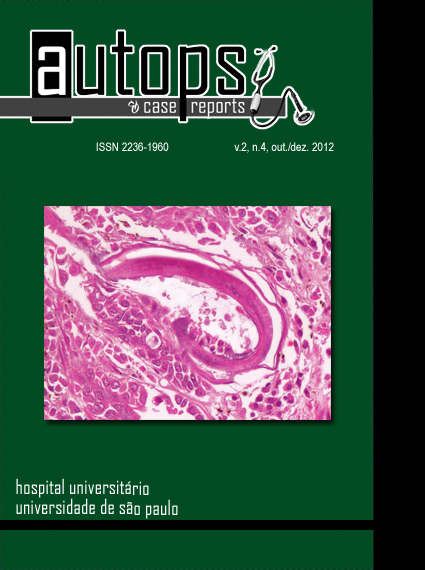Renal tubular dysgenesis with hypocalvaria and ileocecal valve agenesis: an autopsy report
Keywords:
Urogenital abnormalities, Craniofacial abnormalities, Ileocecal valve, Autopsy, Oligohydramnios.Abstract
Renal tubular dysgenesis (RTD) is a rare, lethal, autosomal recessive disorder characterized by non-differentiation of the renal proximal convoluted tubules, resulting in oligohydramnios. It is usually diagnosed in the second trimester of pregnancy, following the oligohydramnios sequence, pulmonary hypoplasia and hypocalvaria. The prognosis is poor, and death usually occurs in utero or within the first few days of life. The pathogenesis of RTD is associated with the perinatal use of drugs, such as angiotensin- converting enzyme inhibitors, angiotensin II receptor antagonists, and anti- inflammatory drugs, as well as with fetal transfusion syndrome, genetic mutations in the pathway of the renin-angiotensin system pathway, cocaine snorting, or other pathological mechanisms that reduce renal blood flow. Here, we report the autopsy of a neonate born to consanguineous parents at 38 weeks of gestation, with RTD, decreased amniotic fluid, oligohydramnios sequence, hypocalvaria, pulmonary hypoplasia, and ileocecal valve agenesis. To our knowledge, the latter has never been reported associated with RTD.Downloads
Downloads
Issue
Section
Article / Autopsy Case Report
License
Copyright
Authors of articles published by Autopsy and Case Report retain the copyright of their work without restrictions, licensing it under the Creative Commons Attribution License - CC-BY, which allows articles to be re-used and re-distributed without restriction, as long as the original work is correctly cited.
How to Cite
Nogueira, A. B., Schultz, R., Liao, A. W., Fancisco, R. P. V., & Zugaib, M. (2012). Renal tubular dysgenesis with hypocalvaria and ileocecal valve agenesis: an autopsy report. Autopsy and Case Reports, 2(4). https://journals.usp.br/autopsy/article/view/48322



